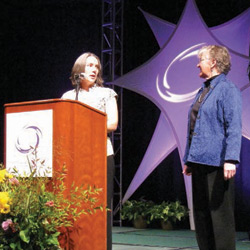
We’re trying to reflect how women think about technology,” says Deanna Kosaraju, vice president of programs at the Anita Borg Institute, of the 2008 Grace Hopper Celebration of Women in Computing. The conference, co-founded by Anita Borg and Telle Whitney in 1994 and inspired by the legacy of Rear Admiral Grace Murray Hopper, balances a broad range of technical talks with professional and personal forums in an attempt to address the interests of women in computing. This year’s theme, “We Build a Better World,” took a holistic approach, emphasizing cooperation, teamwork, and the ability to make a difference. Nearly 1,450 women from 22 countries came together this October for the four-day meeting in Keystone, CO.
This year, in order to help attendees get to know each other, organizers coordinated a variety of networking events during the first two days of the conference. A workshop with leadership coach Jo Miller explored how networking can help women recession-proof their careers; the event was filled to capacity with more than 400 attendees. Both structured and unstructured networking events followed, including a women of color luncheon and a special meeting for first-time attendees, enabling women to put their newly learned skills to the test. Meanwhile, a résumé clinic gave 160 women an opportunity to chat with 40 industry HR representatives and get advice on their résumés.
“It was a great way to break the ice,” explains Anne Condon, conference chair and professor of computer science at the University of British Columbia.
To help women manage their networking goals, the CONNECT project enabled interested attendees to keep track of who they’d met with special scannable barcodes that automatically logged meetings between faculty, students, and industry representatives. Daily email messages summarized the connections each participant had made and included strategies to help them make the best use of their time; more than 16,000 connections were logged over the course of the conference. Social networking technologies like blogs, tweets, and Facebook also helped attendees keep track of one another, and sometimes plan collaborations before they’d even reached the conference.
“People have various ways of communicating, and we try to leverage that,” says Kosaraju.
Another new event this year was the CTO Forum, a series of panels, lunches, and roundtable discussions that gave the female chief technical officers from Xerox, Intel, and other leading technology companies an opportunity to talk about topics of interest to the computing community. Among the subjects they explored were strategies to increase the number of women in computer science, the future of technology, and their own personal experiences. Other technical talks included presentations on Hewlett-Packard’s “skinware” drug delivery technology, emerging energy technologies, data mining, and multi-robot intelligence. Mary Lou Jepson, CTO of Pixel Qi, also discussed her experiences with One Laptop Per Child, a global project to provide underprivileged children with new educational opportunities.
“From a technical perspective, it’s a great place to get a broad view of what’s going on,” says Condon. Yet as difficult as it is to convey the breadth of the conference program, it’s even harder, attendees and organizers agree, to describe just how exciting the atmosphere is.
“Very successful women are willing to talk to people who are just starting out,” says Emily Fortuna, a senior at Rice University. “It’s a very uniting experience.”




Join the Discussion (0)
Become a Member or Sign In to Post a Comment